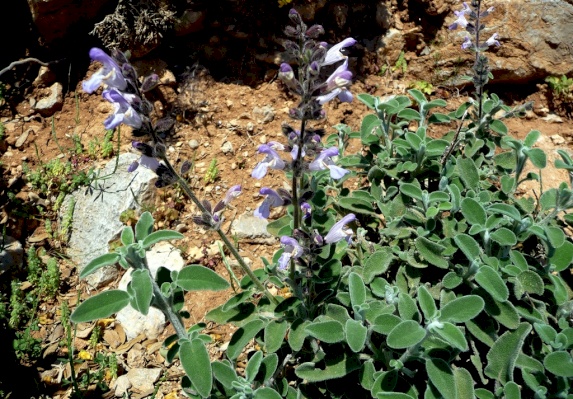Greek sage
Picture Resource: All rights reserved by Annki12
Greek sage is an evergreen plant belongs to the Lamiaceae family. Stem is 60 cm high. Leaves are opposite, entire, dissected once, smooth, whitish-grey and clearly differentiated from S. officinalis due its trifoliate ovate-lanceolate or ovate leaves with typical hairy or tomentose coverings. Leaf blade measures about 8 to 50 mm long and 4 mm to 20 mm wide. The leaf is oval to oblong-lanceolate. The margin is finely crenade and wavy.
Flower stalks 30 cm above the foliage; covered with hairs, lilach, or violet-blue, with a pearly grey calyx and light violet around the edges, hermaphrodite, spikes of flowers long. Flowering periods: March- June
Ecology: It is found growing along dry riverbeds and canyons in rocky soil, it prefers full sun, well-draining soil, and good air circulation, it is very drought resistant. Habitat: Mediterranean maquis and forest. It belongs to the Mediterranean chorotype.
Uses: It has a long tradition in Greece—valued for its beauty, medicinal value, and culinary use, along with its sweet nectar and pollen. It is also grown as an ornamental flowering plant; the leaves have a high oil content, with some of the same chemicals as lavender. It also has a long tradition of use in various Muslim rituals—for newborn children, at weddings, in funerals, and burnt as incense. In its native habitat, it frequently develops woolly galls about 1 inch in diameter which are called 'apples'. These 'apples' are peeled and eaten when they are soft, and are described as being fragrant, juicy, and tasty.
Distributions: It is native to the eastern Mediterranean, southern Italy, Palestine, the Canary Islands, and North Africa.
In Palestine it grows in Mediterranean coast, Woodlands, and Shrublands, Central High land and Jerusalem mountains .
Other names: White Sage, Common Sage, Three-Lobed Sage.
IUCN red list status: least concern
Local status: least concern

